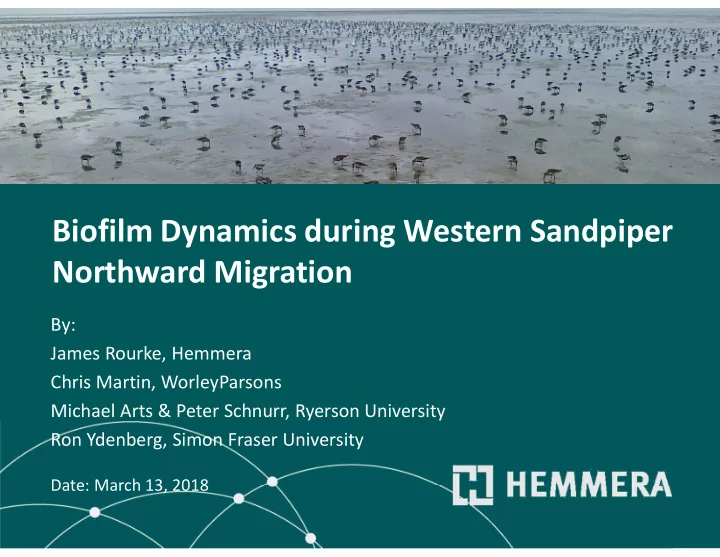

Biofilm Dynamics during Western Sandpiper Northward Migration By: James Rourke, Hemmera Chris Martin, WorleyParsons Michael Arts & Peter Schnurr, Ryerson University Ron Ydenberg, Simon Fraser University Date: March 13, 2018
Biofilm • Thin layer (~2 mm) of diatoms, unicellular eukaryotic algae and cyanobacteria in a polysaccharide matrix (EPS / “snot”) • Known to be eaten by a number of shorebird species • Diet variable depending of site and bird species Roberts Bank: 37-68% daily energy requirements Western Sandpipers (WESA)
Fraser River Estuary (FRE) & Migration • A major stopover site • Supports > 1 million shorebirds annually • Western Hemisphere Shorebird Reserve of hemispheric importance
Study Area Biofilm Distribution and Abundance (Hyperspectral Mapping ) Roberts Bank Fatty Acids? Mapping date: July 31, 2012 Biofilm distribution = 3.25 km 2
Fatty Acids Used by Western Sandpipers during Migration Fatty Acid WESA Total 14:0 5% 16:0 34% Saturated Fats ~ 52% 18:0 11% 20:0 <1% 22:0 2% 16:1 11% Monounsaturated Fats 18:1 30% ~ 43% 20:1 2% 22:1 <1% 18:2 2% 18:3 <1% Polyunsaturated Fats ~ 5% 20:4 <1% 20:5 <1% Omega 3 and 6: <1% 22:6 <1% Source: Egeler and Williams 2000, Egeler et al. 2003
Objectives 1. Identify the suite of fatty acids present during WESA northward migration at Roberts Bank 2. Quantify fatty acid abundances and distributions 3. Investigate abiotic factors influencing fatty acid abundance
Methods: Study Area Sampling Design Study Site Ecological Importance • April 18 – May 12, 2016 • Globally important ecosystem supporting millions of (Spring Freshet) resident, migrating and/or wintering birds of over 100 • 7 Monitoring species annually Stations • Western Hemisphere Shorebird Reserve (WHSR) of • Salinity • Temperature hemispheric importance, RAMSAR Wetland, 3 NWA • Exposure • 6 Surveys • Sediment collected
Methods: Biofilm Parameters Fatty Acids • Total Fatty Acids • Saturated Fatty Acids ( SFA ) • Monounsaturated Fatty Acids ( MUFA ) • Polyunsaturated Fatty Acids ( PUFA ) Metric: mg Biofilm Parameter / m 2 Statistics: GLM, Akaike Information Criteria (AIC)
Results: Relationship Among Fatty Acids • 28 fatty acids were documented 700 r = 0.84 r ² = 0.71 600 P < 0.001 • All fatty acids were 500 Total MUFA (mg/m 2 ) documented at all sites on 400 every survey 300 200 • Fatty acids varied together 100 in abundance 0 50 100 150 200 250 300 350 400 Total PUFA (mg/m 2 )
Results: Fatty Acid Abundance Average Total Fatty Acids : 818 ± 323 SD (mg/m 2 ) Composition 500 • 39% SFA Average Abundance (mg/m 2 ) 400 • 36% MUFA 300 • 25% PUFA 200 100 0 Omega 6 Omega 3 Poly Mono Saturated Fatty Acid Type
Results: Spatial Variation Total Fatty Acid Abundance Fatty Acid Abundance 1400 Average Abundance (mg/m 2 ) 1200 Differences Among Stations: 1000 800 • H,J,X < A,C 600 • J,X < I,Y 400 200 0 H I X J Y A C • Similar pattern documented Stations across fatty acids • SFA, MUFA, PUFA were produced across the salinity gradient under all abiotic conditions
Results: Factors Affecting Biofilm Five Environmental Factors • Water Salinity : High and Low • Water Temperature : High and Low • Percent Time Mudflats Exposed Total Fatty Acids Abundance: Relative Importance of Variable
Results: Environmental Factors Relative Importance of Variables to Influence Fatty Acid Abundance Environmental Factors Percent Time Biofilm Low High Low High Mudflats parameter Salinity Salinity Temperature Temperature Exposed Total Fatty Acid 0.88 0.41 0.20 0.20 0.18 Total SFA 0.92 0.32 0.22 0.19 0.19 Total MUFA 0.92 0.34 0.20 0.20 0.18 Total PUFA 0.34 0.76 0.31 0.21 0.21 Polyunsaturated Fatty Acids Monounsaturated & Saturated Fatty Acids • Annual Spring Freshet • Tidal Cycle / Lunar Cycle
WESA Usage – Northward Migration Western Sandpipers?
Biofilm Fatty Acid Conclusions • A diverse suite of 28 fatty acids is available across Roberts Bank during WESA migration • SFA/MUFA/PUFA were produced under all abiotic conditions and were highly inter-correlated • Comparable (total = 800-1100 mg/m 2 ) SFA, MUFA, PUFA levels were found under all salinity conditions • Fatty acid composition: 39% SFA, 36% MUFA, 25% PUFA • Environmental factors indicates a consistent supply of fatty acids are available to foraging sandpipers
Thank you. Questions? hemmera.com British Columbia | Alberta | Ontario | Whitehorse
Recommend
More recommend